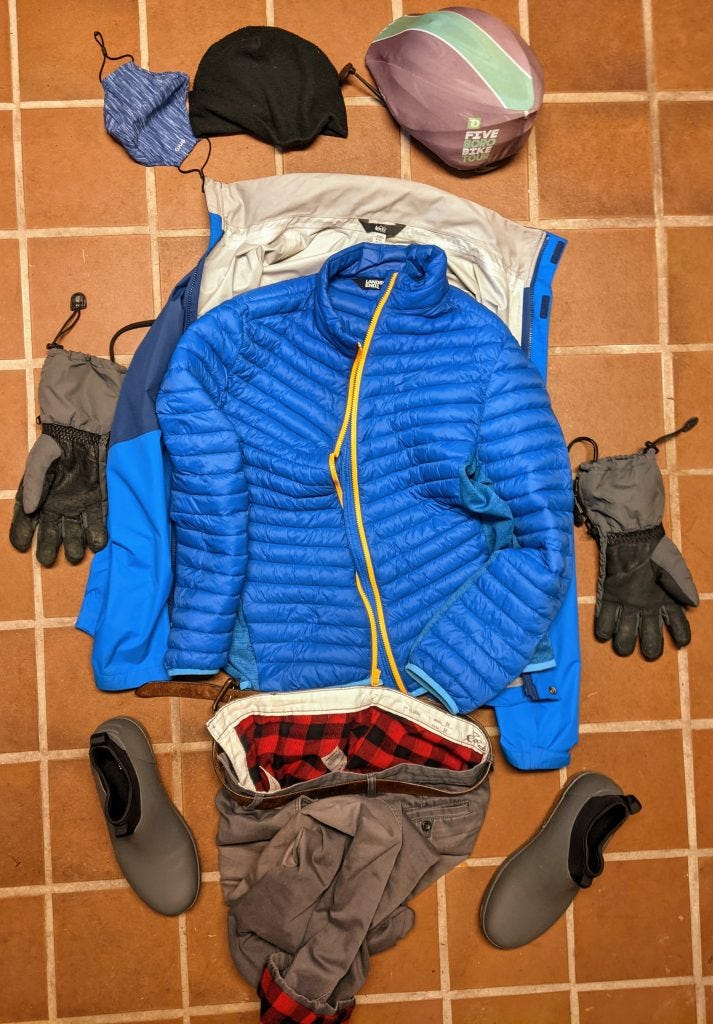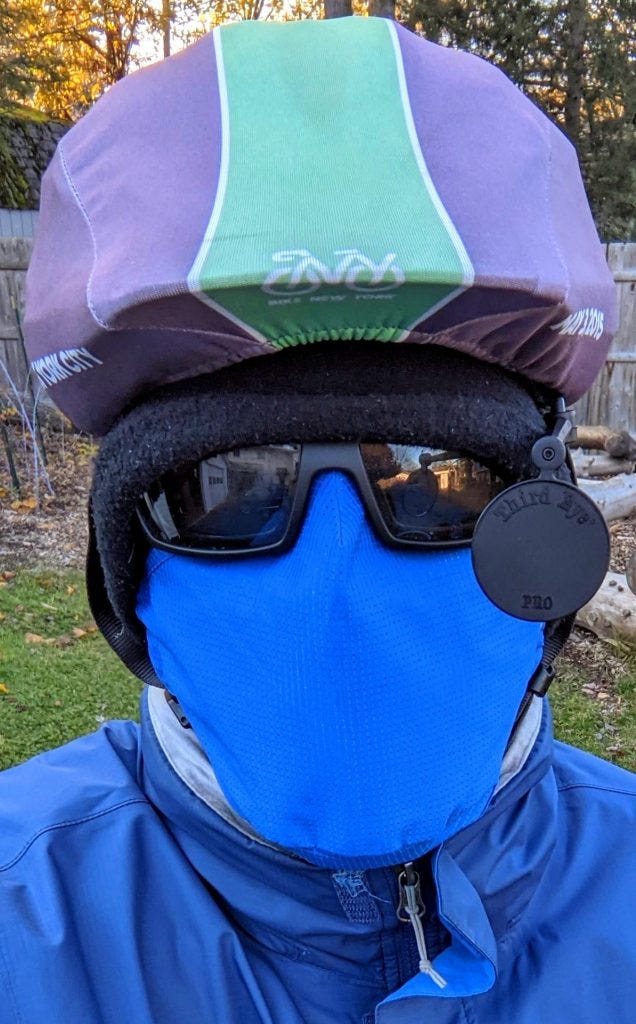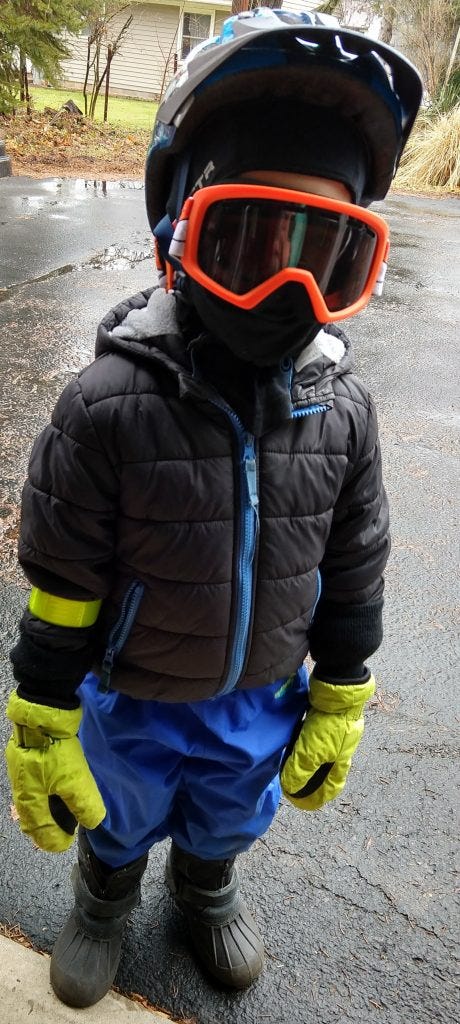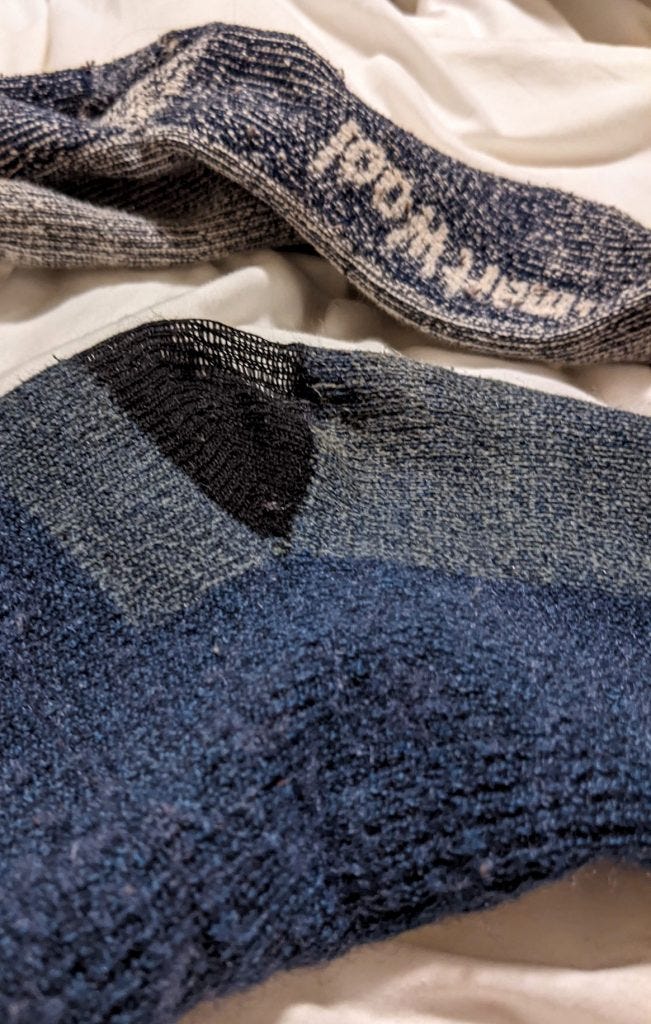What to Wear For Winter Biking if You're a Cold Weather Wimp
UPDATED Feb 2024 with updated links, prices and new info on ski helmets, and bar mitts
It's that time of the year when temps start dropping and lots of people start thinking that they can't bike any more. As an utter wimp when it comes to the cold I used to be one of them. My body can easily handle 100 degree heat, but at 60 F I'm shivering. Luckily, I learned how to pick out clothes to make cold weather biking really comfortable, even for a heat loving guy like me. Read on to learn how you too can bike comfortably, no matter how cold it gets.
What to wear
Most posts you find online about cold weather biking gear are all about pricey stuff for bike racing. That's all well and good for some people, but I primarily use my bike for taking my kids to school, going to the store, riding to work, etc. My cold weather biking clothes are ones that are equally at home both on and off a bike, and they're generally cheaper than cycling specific gear. Here I'll lay out the basics, explain their costs, and how you can mix and match them to ride comfortably even as the weather warms up.
One other note, every body is different. Some people are comfortable at far colder temps than I am (like this guy biking with rolled up pants in 30 F). You can drop my temperature recommendations down a few degrees if your body does better in the cold than mine. Just don't be one of those dudes that stubbornly wears shorts all winter long but refuses to bike then cause it's too cold.
Costs
Costs:
Ski Goggles: $30
Helmet Cover: $8
Half Mask: $11
Hat: $22
Jacket: $150
Thermal: $20
Gloves: $50
Flannel/Fleece Lined Pants: $42
Socks: $15
Shoes: $75
Total: $423In the image above you can see what I wore biking on a cold 18 F day a few years ago (11 F with wind chill). The total cost of all that gear was $423. That may seem pricey but most of that stuff has already lasted 10 years or more. That means cold weather bike clothes can cost under $50/year. Much of it has now reached end of life, but some of the replacements I’ve found for it are even cheaper!
The bigger value comes from the fact that these clothes aren't just for biking. Outside of the helmet cover and the ski goggles I wear all this stuff just walking outside on any normal cold day. This sort of clothing isn't a bike specific investment, it's the stuff that anyone living in a cold environment should own. Living a climate controlled car centered life causes many of us to forget how to handle the elements, but we don’t have to disconnect from nature like this. One of the great positives from biking is ensuring that you'll spend more time out in the real world learning how your amazing body can truly deal with it.
Jackets
The first, and most critical thing you need to ride in the cold is a good coat. My go to for this over the past decade as been a 3 layer Gore-Tex jacket. It's great material, long sleeves, and hem that overlaps with my pants when I'm bent forward biking block wind great. This is critical on a bike when you can easily be going 20 MPH and thus creating your own 20 MPH wind. There's also a great pocket in the chest that I can store my phone in which I love. I didn't realize how amazing this jacket was until it lost its waterproofing and I had to buy a new one (I tried to refresh it with Nikwax, but sadly it still leaks, still great on dry days though).
Cabelas no longer makes my old coat, so I had to shop around. I settled on a REI Rainer rain jacket on sale for $70 as a replacement. I was originally disappointed that this 2.5 layer jacket held less heat than my old 3 layer one but I've made it comfortable in freezing temps by adding a cheap puffer coat under it (see below for deets). I also love how it's hood folds into the collar so it doesn't catch wind and block my rear mirror vision.
2024 UPDATE: After a few years use I can confirm that the cheap puffer+thin wind/rain jacket is all the coat you need, but that this particular REI jacket sucks. Its waterproof lining is flaking off in many places, especially around the collar and not having elastic in the cuffs means you waste time velcroing and unvelcroing them every time you want a tight sleeve fit. It’s currently on sale for $40, but I wouldn’t even pay that for it. I’m looking for a more durable 3 layer jacket that has no PFAS, elastic in the cuffs, a hood (that hopefully either detaches or stowes in the collar), and a front chest pocket to replace the old REI. Unfortunately PFAS are still in a lot of jackets and elastic cuffs aren’t so finding this has been impossible so far. I’m going to keep dealing with my bad REI jacket till this comes along though, if you find it please shoot a link my way in the comments.
Warmer Weather Jackets
The other jacket I ride with is a hi-viz yellow cycling jacket from Canari (similar to this one). This is one of the few cycling specific pieces of clothing that I own, but I've enjoyed it and its lasted well over a decade so far. The main feature I love about it is its zip off sleeves. If you get a little warm on your ride you can zip open the pits, and if you get really hot you can just remove the sleeves entirely and convert it into a vest. This was really useful back when I would commute to work on cold mornings, but then ride back in the heat of early evening. As a cycling specific jacket it also has a little pocket on the back. This feature is great when you're riding a road bike and don't want junk in the front pockets hanging low and brushing your knees. If its not raining this jacket is what I throw on between 50 and 75 F. Given how light my new 2.5 layer rain coat is though, this one is really a luxury, not a necessity.
Under the Jacket
You can layer all sorts of things under the jackets listed above to make them feel good as the temperature drops. I generally start with a t-shirt, then add a flannel shirt over this when it gets colder. I found a puffer jacket on sale from Land's End for just $33 a few years ago (the new, thicker version is currently $44). That's honestly less than the $40 I paid for a thick flannel from them and it's both lighter and warmer.
When it gets really cold I layer the flannel under the puffer, but a cheaper thermal shirt would do just as well if not better. The tan thermal shown in the picture at the top of this article is an unbranded one my dad gave me over a decade ago that I assume cost around $20. It's nothing pretty, but it gets the job done. The best thing about it for me are the extra long sleeves that truly cover my wrists. This is critical for biking below freezing, as you really don't want any gaps in the insulation around your body. To keep warm on a bike on a budget a cheap thermal like this with a puffer and a wind breaker/rain coat on top can't be beat (note for Land's end shoppers, wait for sales there, everything eventually sells for 50-70% off).
Gloves
The final thing you need to keep a jacket warm is a great pair of gloves. Without these your hands and wrists will be cold and air may flow up your sleeves and freeze you. I've used a lot of bad gloves over the years, and I thought that my fingers were just destined to always be freezing in winter. Then my wife bought me these amazing, thick, Goretex gloves from Cabela's and changed my life.
This exact model isn't made anymore, but any waterproof glove with lots of insulation and a gauntlet that goes back over your sleeves and cinches tight would do. If I had to replace them today I'd look at these $56 Gauntlet GTX gloves from REI. It's also possible that some $30 gloves off amazon would work too, just make sure they totally cover your wrists.
Another option is something called bar mitts or pogies. These are big insulated covers that go over your bike handlebars. I bought my wife these $20 Lixda bar mitts and they allow riding in 20 F with just a pair of thin gloves underneath. They totally cover your shifters and any bells or eBike controls you might have, so you have to get comfortable with using those without seeing, but since you’re wearing thinner gloves under them it’s actually easier for your fingers to work these controls if you can visualize them. These cheapo bar mits are really quite warm and their reflective accents help you stay visible in dark winter nights. I don’t think I’d drop $100+ on fancier versions, but combining these with some cheap, thin gloves is probably the most economical way to keep your hands warm on a bike.
Hats & Helmet Covers
Along with your core, the other big thing you need to cover for cold weather cycling is your head. When temps start dropping below 70 F I throw on my helmet cover. I got mine free at the 5 borough bike ride in NYC years ago, but you can find an even better waterproof hiviz cover on amazon for just $11.
When it drops into the 50s I add a thin fleece helmet liner under my helmet. The feature I love for my liner are its ear flaps as cold wind on your ears really sucks. My liner is so old I have no idea where I got it or how much I paid for it, but I'm pretty sure it was cheap, maybe $10? It is pretty thin so I can wear it when it's a little cold without overheating. Another good option is a wrap around ear warmer as your ears will get coldest first.
For the 40s and below I switch to my thick turtlefur beanie. I'm not sure what it is about this hat that makes it so much better than other beanies I've tried, but with the helmet cover mentioned above it, it gets me through just about anything, even 0 F days.
The other option is to get a full on insulated ski helmet. I bought my kids ski helmets years ago and seeing how much they loved them I finally had to buy my own. I mistakenly didn’t get one with a sun visor, but I was able to jerry rig that by cutting up an old hat and mount a mirror on it too. This is now my winter riding head gear with a thin hat under it to cover my forehead on days under 25 F.

Face Covering
Below the hat, you'll also want to cover your face. Leaving little to no skin exposed is crucial to biking comfortably in the cold. One of the few benefits of COVID is that it's now much more normal to walk around with a face mask on. I expect to keep biking in my XL Enro face masks whenever it's 50's or below even after the pandemic ends. They totally eliminate chapped lips and wind burn and keep my face nice and warm even when the outside air is freezing (using some chap stick on your lips is still a fine idea though).
The big issue with masks is fogging glasses. I avoid this by keeping the top of the mask pinned to my face under my glasses nose pads. Somehow this isn't common knowledge multiple years into the pandemic, but if you haven't heard it yet now you know.
Down in the 20s I'll cover my mask with an old insulated half mask (here’s a newer half mask for $30). The must have feature for a half mask is velcro in the back so you can take it off while riding. Someone gave me a turtlefur neck gaiter once, but since I have to pull it over my head to remove it when I get hot I just can't ride with it at all. Even if you can stop to remove it, it will ruin your hair when you take it off. Just say no to neck gaiters and balaclavas and get a hook and loop insulated half mask instead.
Eye Covering
When it's really cold you're going to want to cover your eyes too. Having little to no exposed skin is the key to riding comfortably in cold weather. The new option I've been using for a few years now is a pair of Wiley X Tide prescription glasses (you can see them in my helmet and blue face mask pic above). These have a thin removable foam seal on the inside of the glasses and an elastic strap that attaches to the glasses arms and holds them tight on your head. I bought them primarily as safety glasses to use with woodworking, but these features let them function like slimmed down ski goggles too. I’ve ridden them down to 10F and they don’t keep my eyes as warm as ski goggles, but the ease of use of just throwing them on my face makes up for that. The foam insert is degrading a bit now, but apparently Wiley sells an upgraded foam insert for $20. The only real negative of the Wiley glasses is that being curved distorts my prescription in them a bit. They also fog a little if you wear them wrong, but that’ll happen with any glasses.
For serious warmth and the least fogging possible you’re really going to want some ski goggles. There are endless options for that, so I'll just say find a pair that works for you. Here are my son’s :).
Everything Below the Waist
The most neglected part of winter cycling wear is found below the waist. Since you're pedaling with your legs they can stay pretty warm on their own, but I still prefer to add some insulation and wind blocking to them. Feet are the last piece of the puzzle and you'll definitely want to keep them warm as well.
Lined Pants
The first thing most people think of if their pants are too cold is long underwear. Mr Money Mustache wrote a lovely ode to this in The Oil Well you can Keep in your Pants, but my leg hairs distinctly do not like tight long underwear so it's a no for me. Instead my secret weapon is flannel lined pants. These look just like normal slacks unless you roll up the cuffs to show off whats underneath. I have two pairs of flannel lined pants that I rotate in winter, one from Lands End, and a new fleece lined Eddie Bauer pair. You can also get flannel lined jeans if you want a bit more durability or a slightly different look. Whatever you do, make sure your legs have enough insulation for the conditions you're riding in.
Rain Pants Rule!
I'd never heard of breathable rain pants before I met my hydrologist wife, but now I never want to live without them. I had Marmot rain pants that lasted 6 years but waterproof membrane degraded in the area where my legs rub against the seat so I had to replace them. My new rain pants are the Endura Urban Luminite Pants. They’re designed for biking so hopefully they last longer, and they also have some nice reflective panels. Best of all they’re PFAS free and their adjustable cuffs are actually long enough for my legs.
Rain pants are great in the cold too. If it's below 18F I'll throw a pair on top of my flannel lined pants. This basically makes some DIY snow pants that are perfect for biking. Even if when its dry the rain pants act as a wind break and add a tiny bit of insulation that keeps my legs comfortable all the way down to 0 F. They're also great if it's warmer and raining and a worthwhile addition to any closet.
Socks
The right socks are also key or cold weather biking, and really just living in winter in general. I mostly use some generic thick wool + acrylic mix socks I got for Christmas a decade back. These are starting to wear a bit thin though, while my fancier and older Smartwool pair is still nice and thick. I’ve gotten some thinner Darn Tough socks that work down to around freezing and I like their lifetime warranty, though my Smartwools have lasted so well I don’t think it’s needed. Some cyclists recommend wearing sandals with waterproof socks in the winter, but that's a bit too out there even for me. I'll stick with the warmth of thick wool socks under waterproof shoes, then switch to thinner socks as the weather warms up.
Shoes
Finally, on top of socks you’ll need some shoes, they're the last critical detail for cycling. I prefer my shoes to not have laces for easy on/off, and the added benefit of never getting a lace caught in your chain while pedaling. I don't like being locked in while riding my kids around either and walking on clipless pedals is just a pain so I look for regular shoes that also work for biking.
During warmer weather I wear the wonderful Five Ten Sleuth slip ons because of their sole's amazing grip on my pedals (just make sure to order 1/2 size smaller than usual). I added a Power Grips strap to my left pedal to make it easy to reset the pedals at a stop. I didn't put one on my right so I could still instantly put that foot down when I stop. They sell these in pairs so doing it this way means you can equip two bikes with just one set.
Once it gets cold I’d break out my Staheekum Neoprene and rubber boots (currently $60, but I got them on sale for $36). The insoles are very comfortable and the insulation is decent. The only real problem is that they look boring and the pull tab has separated at the back of one of mine, but my rain pants cover that up, so I still wear them. Their soles don't grip the pedals nearly as well as my Five Ten's, but the Power Grips strap ensures that at least my left foot will never slide off the pedal.
When I’m riding somewhere that I need to look a bit more professional I throw on these insulated, waterproof Chelsea boots from Will’s Vegan Store. Their 12 is tighter than the Staheekum’s so they only fit thinner socks, but their insulation is better so total warmth is about equal. They’re definitely a bit pricey, but that’s what you pay for for such comfort, style and functionality.
That's it
Car culture has brought many people to a point where they simply don't dress for the weather any more. Wearing a t-shirt and shorts in December may work if you're inside a climate controlled box all day, but cycling forces you to actually engage with the weather. Luckily, there have been great advances in clothing technology that now make this easy, comfortable and cheap. Hopefully the above advice will help you get the clothes you need to be comfortable biking no matter the weather, and we can all profit greenly together.
















Incredibly janky port of comments from my old WordPress site:
GreenMarketer
2022-01-13 at 4:41 pm
Love your post! I’ve spent the past few months stepping up my winter wear game so it’s comfy to ride… but it still isn’t there (yet).
Your advice about lined pants and eyewear is exactly what I need to get myself out there on the coldest days of the year (windchill of 0-10 F or so)
Thanks again!
Incredibly janky port of comments from my old WordPress site:
Andrew
2021-12-17 at 5:08 pm
Solid advice, though the temperatures you cite do certify you as a cold weather wimp. 😉 For a different perspective, I’m a furnace when I bike. My keys from 10 years of Alaska are: layer up and start cold. Zipper layers and especially pit zips in your wind layer are key to maintaining good temperature. I usually end rides well vented, even when below 0F. Your hands and feet are critical as they aren’t moving. I wear full on winter boots to solve the feet (many use toe warmers). Pogies are excellent and I often go barehanded on the bars at 10F in them once I’ve warmed up, and mine are just the lightweight neoprene ones. I’ve never found eye coverings to be worth it (though I’m under 10 mph on my fat bike) and I embrace the ice beard and usually forgot face covering too. The key is to experiment with what you have and take note at different temperatures what works for you. Buy new things last.